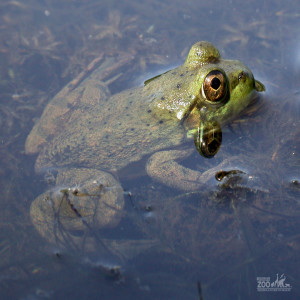American Bullfrog
[Lithobates catesbeiana]

The bullfrog is the largest frog in North America, ranging from 3.5 to 8 inches long. The color is shades of green to brownish above with random mottling of darker gray. There is a large external eardrum (larger in males than in females) on the side of the head. The hind feet are fully webbed except for the last joint of the longest toe. The belly is cream to white, and may be mottled gray.
Location: Animals Formerly at Zoo
Share:
Range
The range of the American bullfrog is eastern and central USA, New Brunswick and Nova Scotia.
Habitat
The American bullfrog prefers ponds, lakes, and slow-moving streams with sufficient vegetation for cover.
Conservation Status
Least ConcernPrimary Threats
Human- Wildlife Conflict.Gestation
Incubation: Eggs - about 14 days. Tadpoles take 4 months to 2 years to metamorphose
Litter
Clutch size: up to 20,000, but average 6-7,000
Behavior
Bullfrogs are nocturnal. Although primarily aquatic, if frightened they flee to nearby vegetation as often as to water. North American bullfrogs prefer warm weather and will hibernate during cold weather.
Reproduction
The bullfrog's breeding season is from May to July in northern areas, and February to October in southern areas. Aggregations of males will call in chorus to attract females to the breeding site. The egg masses are attached to submerged vegetation. They must not be incubated at temperatures above 82 degrees. Most such eggs develop abnormally and die. About 4 days after fertilization, tadpoles emerge with gills and a tail. Tadpoles mature slowly, taking 1 – 3 years to reach adult stage (depending on location – a few months in the south, 3 years in Nova Scotia). These frogs breed once a year and there is no parental involvement after the eggs are laid.
Wild Diet
Insects, crayfish, minnows, other frogs. Larger specimens have eaten small birds, young snakes, small mammals.
Zoo Diet
Earthworms, crickets, superworms
